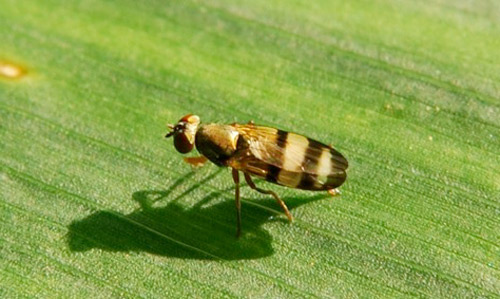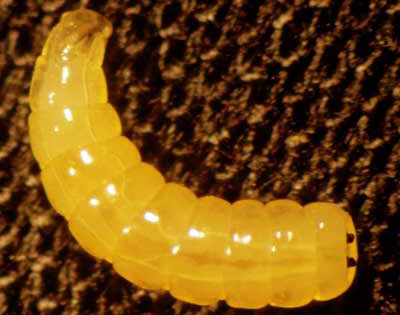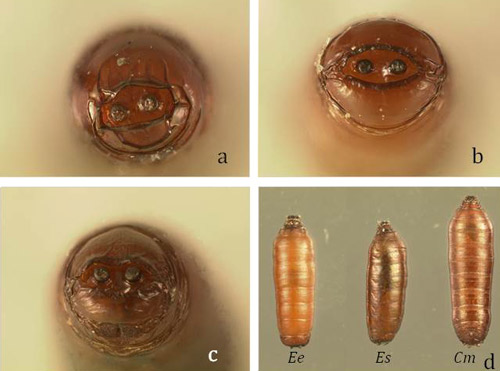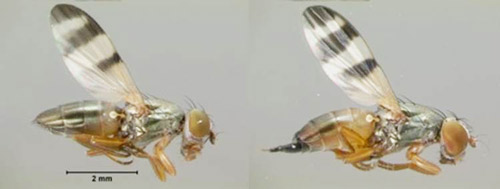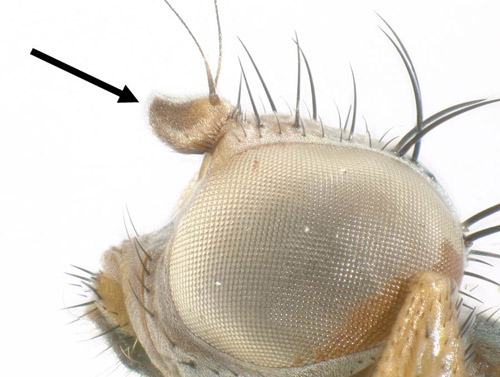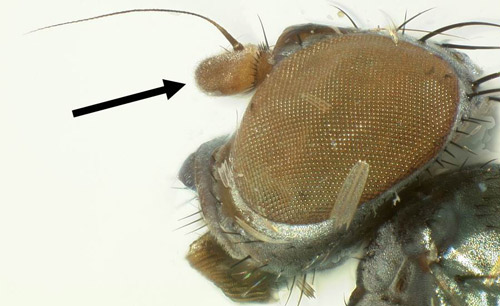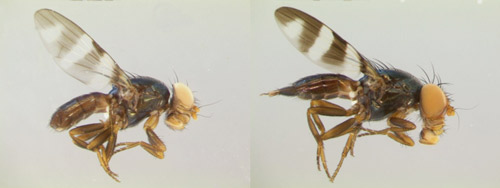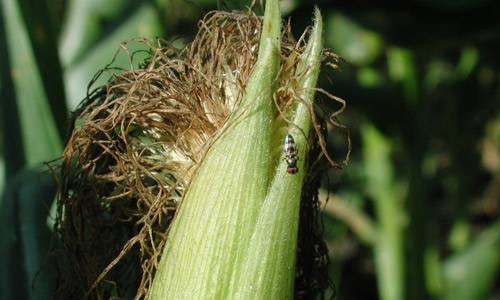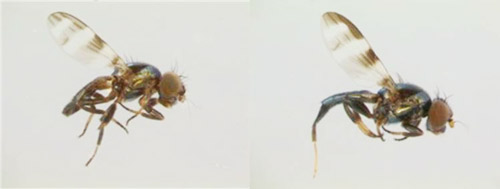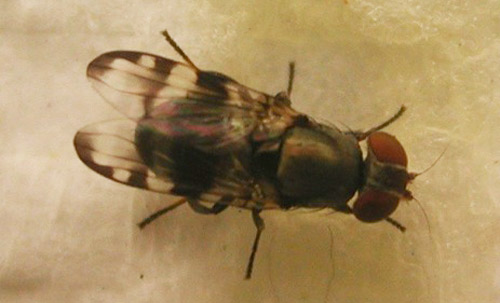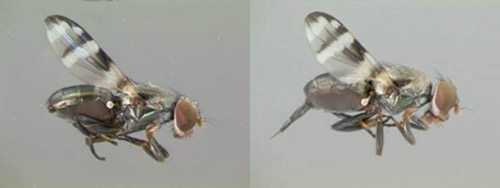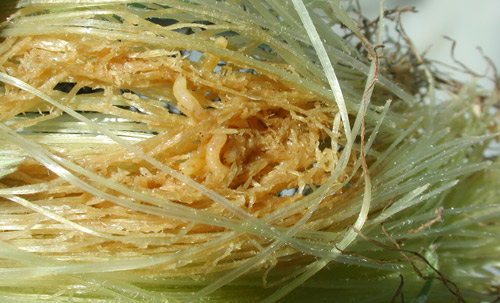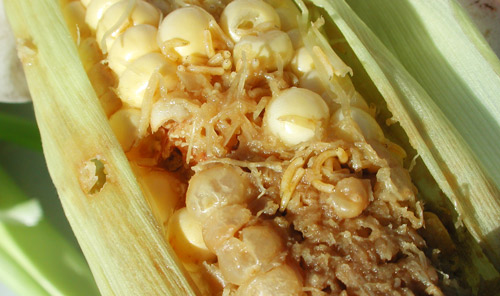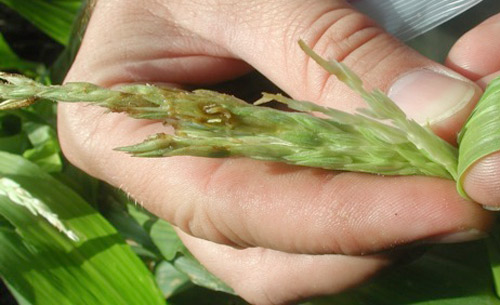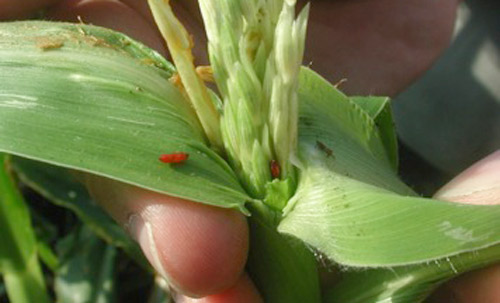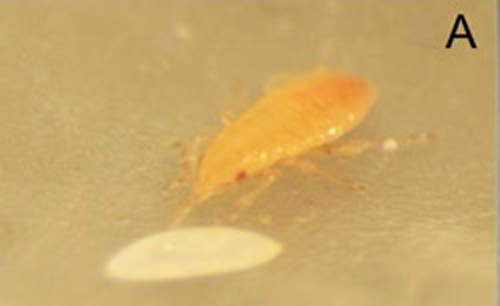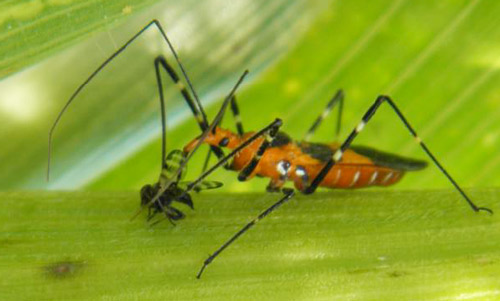common name: cornsilk fly (suggested common name)
scientific name: Euxesta annonae (Fabricius) (Insecta: Diptera: Ulidiidae)
scientific name: Euxesta eluta Loew
scientific name: Euxesta stigmatias Loew
scientific name: Chaetopsis massyla (Walker)
Introduction - Distribution - Life Cycle and Description - Host Plants - Damage - Natural Enemies - Management - Selected References
Introduction (Back to Top)
Cornsilk flies are attractive, medium to dark metallic green to black colored flies with distinctive wing patterns and wing flapping behavior. They are commonly found throughout Florida’s agricultural communities. Their normally saprophytic life style belies their destructive nature when it comes to their preference for sweet corn ears. Entire fields may have to be passed up for harvest if they go untreated for these destructive pests, or if individual treatments were missed due to weather, time or other constraints. Ears produced for seed and silage corn are also vulnerable to attack, but damage to these field corns often goes unnoticed due to less frequent scouting. Four species of cornsilk flies are known to attack corn in Florida: Chaetopsis massyla (Walker), Euxesta annonae (Fabricius), Euxesta eluta Loew, and Euxesta stigmatias Loew.
Figure 1. Chaetopsis massyla on corn leaf. Photography by Gregg Nuessly, University of Florida.
Distribution (Back to Top)
Cornsilk flies are found in tropical and subtropical areas of the western hemisphere. They occur throughout Florida, Puerto Rico and the Caribbean Islands, Mexico, Central and South America south to Argentina and Chile. Historically they have been pests of sweet corn in southern Texas and California, but modern reports of damage by 'cornsilk flies' in the United States are restricted to Florida, Georgia and Puerto Rico. Chaetopsis massyla is found on corn throughout Florida and north into South Carolina, Georgia, Alabama and Louisiana. Euxesta eluta is found throughout Florida and extends north only into Alabama and Georgia. Euxesta annonae and Euxesta stigmatias are found in Florida corn from Orlando south to the end of the peninsula (Goyal et al. 2011a). Euxesta annonae and Euxesta stigmatias are found in the Hawaiian Islands, but there is no record of them attacking corn there.
The genus Euxesta is represented by 36 species in North America north of Mexico and 69 species in the Americas south of the United States (Steyskal 1965 and 1968). At least three additional Euxesta species are known as corn pests in Central and South America, including Euxesta major Wulp, Euxesta mazorca Steyskal, and Euxesta sororcula (Weidemann) (Branco et al. 1994, Evans and Zambrano 1991, Frias 1981, Painter 1955, Steyskal 1968 and 1974).
The genus Chaetopsis is represented by seven species in North America and ten species in the Americas south of the United States with four species common to both (Steyskal 1965 and 1968). Chaetopsis aenea (Wiedeman) and Chaetopsis fulvifrons (Macquart) have also been found on corn in the United States, but only in association with stem damage caused by other insects.
Life Cycle and Description (Back to Top)
Adults can be found throughout the year in south-central through southern Florida. The adults are adept at finding both adult and larval food sources. Chaetopsis massyla and Euxesta stigmatias complete development on sweet corn in the field in 17 (May) to 34 (Dec) days and adults live 36 to 52 days, respectively. Euxesta eluta completes development on sweet corn in the field in 19 (May) to 36 (Dec) days and adults live an average of 86 days. Therefore, many overlapping generations are possible each year. Tolerance to freezing conditions is unknown, but air temperatures < 3.5 °C (40 °F) forces late instar larvae to leave corn ears and seek shelter at or below the soil surface. Larvae and pupae can only be identified to species using minute structures visible with a microscope. However, adults are readily identified using several characters visible with the naked eye or a hand lens. Biology is described by App (1938), Seal and Jansson (1989, 1993), Seal et al. (1995, 1996), Hentz and Nuessly (2004) and Goyal et al. (2010a and b, 2011b, 2012a and b).
Eggs: Females cannot penetrate intact plant tissue with their ovipositor. In most cases, they deposit eggs into damaged, cracked, or decomposing plant tissue. In corn, eggs are deposited principally at the tip of the ear, within the silk, at the point of emergence from the ear (Figure 1). Eggs are less commonly deposited between the husk leaves and around feeding holes in the husk caused by larval fall armyworm, Spodoptera frugiperda, and corn earworm, Helicoverpa zea. Adults will deposit eggs in ears with green and browning silk; therefore, sweet corn ears are susceptible to infestation by the flies to within a few days of harvest. In the absence of ears, all four species may deposit eggs at the base of leaves, in whorls infested with fall armyworm, or in the tassel, but survival rates are much lower than when they are deposited in ears. Eggs measure about 0.85 mm in length and 0.16 mm in width. They are white in color and cylindrical in shape, with ends that taper to a broadly rounded point. Eggs are usually deposited in small groups of 10 to 25 upwards to 40. Many females may deposit eggs within individual ears resulting in hundreds of eggs in each ear. Duration of the egg stage is 28 to 42 hours at 26.5 °C (80 °F).
Figure 2. Euxesta stigmatias eggs in cornsilk. Photograph by Megha Kalsi, University of Florida.
Larvae: Larvae are elongate and cylindrical in shape, with a blunt, broadly rounded posterior that tapers to a pointed head that is equipped with a pair of mouth hooks (Figure 2). Two peg-like, black spiracles are clearly visible on the blunt end of their abdomen. The ventral surface bears ridges and coarse spines. Larvae complete development in 10 to 16 days, passing through three instars. Mature larvae range in size from (length × width) 6.2 × 0.9 mm (Euxesta stigmatias) to 8.2 × 1.2 mm (Chaetopsis massyla). Larvae are whitish in color during the first two instars and become pale yellow during the final third instar. Larvae feed on cornsilk, cob and pre-black layer stage kernels in ears, but can also be found feeding on fall armyworm-damaged leaves and tassels within the corn whorls.
Figure 3. Last instar larvae of the cornsilk fly, Euxesta stigmatias. Photograph by Matthew Hentz, USDA, ARS, Ft. Pierce, Florida.
Pupae: The majority of larvae leave the ear to pupate within the top 2 cm of the soil surface. Some pupation occurs on the corn silks within or outside of the silk channel. Larvae propel themselves from the corn ears by first grabbing the end of their abdomen with their mouth hooks and then quickly flexing their muscles to flip into the air to the soil. The puparia are elongate, cylindrical, slightly flattened with the anterior end tapered to a blunt point (Figure 3). Pupae can be separated to genus by the shape of the posterior plate. Pupae measure (length × width) 3.9 × 1.4 mm (Euxesta stigmatias) to 5.0 × 1.6 mm (Chaetopsis massyla). Euxesta stigmatia pupae are light brown, while Euxesta eluta and Chaetopsis massyla pupae are redish brown in color. Puparia darken at maturity due to dark body and wing colors of the developing adult structures. 'Cornsilk flies' complete pupal development in five to seven days in May and six to eight days in December.
Figure 4. Pupae of 'cornsilk flies': Posterior views of Chaetopsis massyla (a), Euxesta eluta (b), Euxesta stigmatias (c); view of three species; Ee, Euxesta eluta, Es, Euxesta stigmatias, Cm, Chaetopsis massyla. Photograph by Gaurav Goyal, Monsanto Corporation.
Adults: Chaeotopsis massyla adult flies have a medium metallic green body, yellowish legs, and three black dark bands on the front wings (Figures 4 and 5). Adults of Euxesta spp. attacking corn in Florida are dark metallic green to black, with brown to black legs, and four pale to dark brown bands on the front wings. The arista is attached to a pointed first antennal segment in Chaetopsis massyla (Figure 6) while a rounded one in the three Euxesta spp. (Figure 7). The wing patterns of Euxesta annonae (Figure 8) and Euxesta stigmatias (Figures 9 and 10) are the most similar of the four species, but the pattern of Euxesta stigmatias is paler than Euxesta annonae and fades from the front to the rear wing margin. The banding pattern in Euxesta eluta is offset slightly between the 3rd and 4th bands resulting in a clear round to oval spot near the front wing margin that is visible no mater the wing position (Figures 11 and 12). Males are shorter than females in all four species. Male Euxesta annonae and Euxesta stigmatias measure about 3.8 mm in length, females about 4.2 mm. Euxesta eluta are slightly longer than the other two Euxesta spp., while Chaeotopsis massyla are 2 to 2.5 mm longer than Euxesta eluta. The terminal end of the male abdomen is rounded, while that of the female ends in a trapezoid-shaped segment. The flies move their wings and walk in specific patterns in response to presence of other adults of their species, but also at other times when they are walking individually on plants. Adults are frequently observed sunning themselves early in the day, but quickly move into the shadows as sunlight grows more intense. Mating occurs principally at dusk and dawn.
Figure 5. Chaetopsis massyla male (left) and female (right). Photograph by Gaurav Goyal, University of Florida.
Figure 6. Chaetopsis massyla head showing edge of 1st antennal segment. Photograph by Gaurav Goyal, University of Florida.
Figure 7. Euxesta spp. head showing rounded edge of 1st antennal segment. Photograph by Gaurav Goyal, University of Florida.
Figure 8. Euxesta annonae male (left) and female (right). Photograph by Gaurav Goyal, University of Florida.
Figure 9. Euxesta stigmatias on sweet corn ear. Photograph by Gregg Nuessly, University of Florida.
Figure 10. Euxesta stigmatias male (left) and female (right). Photograph by Gaurav Goyal, University of Florida.
Figure 11. Euxesta eluta in colony. Photograph by Gregg Nuessly, University of Florida.
Figure 12. Euxesta eluta male (left) and female (right). Photograph by Gaurav Goyal, University of Florida.
Host Plants (Back to Top)
Larvae and adults feed on a wide variety of discarded or culled plant matter in abandoned fields or following harvest, including many other vegetables (e.g., cabbage, tomato, and peppers), fruits (e.g., atemoya, banana, guava, avocado, and papaya), and root crops (sweet potato and radish), but they do not infest most other marketable fruits and vegetables in Florida (Goyal et al. 2012a). These flies are known to complete development in field crops (e.g., sorghum and sugarcane), weeds (e.g., spiny amaranth, little hogweed, and Johnson’s grass) and native plants (e.g., southern cattail) that have been damaged by other insects [e.g., Diatraea saccharlis (Lepidoptera: Crambidae)] or machinery. Euxesta annonae has been recorded developing from annona fruit in the state; however, sweet corn and field corn are highly preferred, and the only crops to be economically damaged. Adults feed on pollen, sugary plant exudates, and fluids leaking from plant tissue damaged by their larvae, by other insects or from mechanical damage resulting from field equipment.
Damage (Back to Top)
Plant damage is caused by the larval stage. Damage to cornsilk results in poor kernel set and resulting asymetric kernel size and rows on the cob. The silks turn a bronzed brown color along the path of larval feeding and under heavy infestation all of the silk will be clipped off within the silk channel (Figure 13). While low numbers of larvae (<5) do not cause significant damage to cornsilk, larger numbers of larvae result in wet, decomposing cornsilk within the silk channel making the ear unmarketable without trimming to remove the ear tips. Larvae also feed on the tip of the cob resulting in blank tips. Larvae that feed down into the ears cut into developing kernels, where they often hollow out the kernels (Figure 14). Larvae may be found feeding along the entire length of the ear. Field corn kernels can also be damaged prior to the R3 stage, but in general the thicker pericarp of field corn results in fewer kernels damaged compared to sweet corn ears. Members of both genera also feed (Figure 15) and pupate (Figure 16) on developing tassels within the whorl. Yield reductions in sweet corn can reach 100%, with peak levels of damage early in the season in extreme southern Florida following summer vegetable crops (Seal and Jansson 1989, Seal et al. 1996) and at the end of the spring season in the Belle Glade region due to concentration of flies with diminishing sweet corn availability. Significant damage can occur when insecticides have not been properly timed to kill adults before they deposit eggs in ears. At-harvest ear infestations greater than 30% usually result in the field being rejected for fresh market; however, corn with minor tip damage from fly larvae, fall armyworm or corn earworms can be trimmed and marketed in tray packs without loss of quality.
Figure 13. Damage to sweet corn silk by Euxesta spp. and Chaetopsis massyla larvae. Photograph by Gregg Nuessly, University of Florida.
Figure 14. Damage to sweet corn kernels by Euxesta spp. and Chaetopsis massyla larvae. Photograph by Gregg Nuessly, University of Florida.
Damage to tassels before they fully emerge and open from the whorl occasionally occurs due to feeding by larval Euxesta spp. and Chaetopsis massyla.
Figure 15. Damage by Chaetopsis massyla larvae to sweet corn tassel within or just emerging from corn whorl. Photograph by Gregg Nuessly, University of Florida.
Figure 16. Chaetopsis massyla pupae in sweet corn tassel within whorl. Photograph by Gregg Nuessly, University of Florida.
Natural Enemies (Back to Top)
Little is known concerning the affect of natural enemies on cornsilk flies in nature. Recent work by Kalsi (2011) provides the first quantitative information on the relative importance of predators in the laboratory. Eggs and larvae are consumed by earwigs (Dermaptera: Forficulidae), mites (Acarina), minute pirate bugs (Hemiptera: Anthocoridae: Orius spp.), lacewings (Neuroptera: Chrysopidae: Chrysoperla spp.) and rove beetles (Coleoptera: Staphylinidae). Rove beetle adults, lacewing larvae and Orius insidiosus adults (Figure 17) consumed 20 eggs and up to 35 1st and 2nd instarEuxesta spp. larvae per day in petri dish bioassays. Orius insidiosus nymphs also fed on eggs (Figure 18) and small Euxesta spp. larvae. Assassin bugs, such as Zelus longipes Fabricius (Hemiptera: Reduviidae) and many spider species feed on adults of all four 'cornsilk fly' species. Zelus longipes needs 40 to 85 minutes to complete feeding on a Euxesta spp. adult depending on the sex of the predator and the fly species (Figure 19). The density of these predators ranges widely in sweet corn produced in Florida depending on the season, location, rate and type of insecticides applied to control fall armyworm, corn earworm and 'cornsilk flies'. Additional work is needed to evaluate predator efficiency on larvae within corn ears and adults on the plant surface before the relative value of these predators in the field can be estimated. No parasitiods have been found associated with these species in Florida, but larval and pupal parasitoids of Euxesta stigmatias have been discovered in Sinaloa Mexico, Santa Fe Province Argentina, and Sete Lagos Brazil (Báez et al 2012, Bertolaccini et al. 2010, Valicente 1986).
Figure 17. Adult Orius insidiosus feeding on a third instar larva of Euxesta stigmatias. Photograph by Megha Kalsi, University of Florida.
Figure 18. First instar Orius insidiosus nymph feeding on a Euxesta spp. egg. Photograph by Megha Kalsi, University of Florida.
Figure 19. Zelus longipes feeding on Euxesta stigmatias in sweet corn field. Photograph by Megha Kalsi, University of Florida.
Management (Back to Top)
Eggs and larvae of this insect are protected within corn ears, and pupae are sheltered beneath the soil or within the ears. Therefore, current control strategies target the adult stage. Treatment thresholds are poorly developed; however, sampling should commence before tassel push and continue up to harvest to detect adults within sweet corn fields. Adults can be difficult to observe as they are easily disturbed and frequently sit in shaded portions of the plants near the soil surface during the daylight hours. Adults are more easily detected in the early morning and late afternoon or early evening when they rest and interact with each other on the upper stalk and tassel. During silking, the silk channel should be checked for the presence of eggs, paying particular attention to the areas near the tips of the husks. Weed management within and surrounding fields is very important to reduce habitat used by the flies for protection from insecticides applied by air. Growers should control weeds mechanically and chemically as needed prior to layby to maximize the capacity for insecticidal control of the adults.
Growers in affected areas rely on frequent insecticide applications to maintain a toxic residue on the rapidly developing corn silk. Timing and selection of insecticides is critical to reduce damage in the presence of these pests. Infested fields should be treated with effective insecticides to reduce the population before silks emerge from the ears. These flies can quickly re-enter insecticide-treated fields from surrounding crop reservoirs, particularly surrounding sugarcane and untreated sweet corn fields. Flies entering the fields are first found within 50 rows of field edges (125 ft), but spread throughout fields within 48 hours (Goyal 2010b).
Organophosphate and pyrethroid insecticides were the most effective at killing corn silk flies in bioassays conducted in 2002 (Nuessly and Hentz 2004). However, rates, formulations and pre-harvest intervals of chlorphyrifos have been reduced since that time, resulting in nearly complete reliance on pyrethroids for adult management. Residues of all effective insecticides tested kill less than 40% of flies on plants 24 hours after treatment. Therefore, frequent insecticide application is required to continue to kill new adults entering fields to reduce egg deposition within ears. To prolong the effectiveness of pyrethroids, other insecticide classes should be used to control insects during the vegetative growth, reserving pyrethroids for these flies during the ear stage. New inseciticides and alternatives to insecticides are currently being evaluated to try to improve control of these important sweet corn pests. Research has found that cultivars with high levels of maysin in cornsilk have some resistance to ‘cornsilk fly’ larvae (Scully et al. 2000). GMO corn varieties that were developed to control Lepidoptera pests such as fall armyworm, corn earworm, and European corn borer do not provide any protection against these fly pests and should be rigorously scouted throughout the ear stage for these flies.
In very small fields or homeowner situations, covering the ear beginning at initial silk emergence with a homemade mesh bag (e.g., bridal veil material, 20 × 20 to 32 × 32 mesh) held tightly around the middle of the ear with string or rubber bands is an efficient method to greatly reduce egg deposition by the flies without interfering with pollination.
Similar Euxesta species are found in maize and vegetables throughout North America, but they are not currently considered to be pests. For example, there are 24 species of Ulidiidae in North America east of the Mississippi River, but only four of those are considered pests. Therefore, unless you are familiar with the different species in your area, specimens should be properly identified to species by a reliable taxonomist as soon as they appear to determine whether they pose a threat to the corn crop.
For more management information, see:
Florida Pest Management Guide for Sweet Corn.
Florida Pest Management Guide for Field Corn.
Selected References (Back to Top)
- App, BA 1938. Euxesta stigmatias Loew, an otitid fly infesting ear corn in Puerto Rico. Journal of Agriculture of the University of Puerto Rico 23: 181-187.
- Báez JRC, Gutiérrez CG, Ocampo MM, Bojorquez DA, Pérez EN, Hernández JIV, Guitrón UG. 2012. Enemigos naturales de las moscas de los estigmas del maíz: Euxesta stigmatias (Loew), Chaetopsis massyla (Walker) y Eumecosommyia nubila (Wiedemann) en Guasave Siulaloa, México. Ra Ximhai 8(3) Septiembre - Diciembre. (8 April 2013)
- Bertolaccini I, Bouzo C, Larsen N, and Favaro JC. 2010. Especies del género Euxesta Loew (Diptera: Ulidiidae (=Otititae)) plagas de maíces dulces Bt en la provincial de Santa Fe, Argentina. Rev. Soc. Entomol. Argentina 69: 123-126.
- Branco MC, Villas Boas GL, Reifschneider FJB, Cruz I. 1994. Evaluation of resistance to Helicoverpa zea (Lepidoptera: Noctuidae)(Boddie) and Euxesta sp. (Diptera: Otitidae) in lines of sweet corn. Anais da Sociedade Entomologica do Brasil 23: 137-140.
- Capinera JL. Handbook of Vegetable Pests. Academic Press, San Diego. 729 pp.
- Evans DC, Zambrano E. 1991. Insect damage in maize of highland Ecuador and its significance in small farm pest management. Tropical Pest Management 37: 409-414.
- Frias D. 1981. Diferencias de microhabitats entre Euxesta eluta y Euxesta annonae (Diptera, Otitidae). Agricultura Tecnica (Chile) 41: 89-94.
- Goyal G. 2010a. Morphology, biology, and distribution of corn-infesting Ulidiidae. PhD dissertation, University of Florida.
- Goyal G, Nuessly GS, Steck GJ, Seal DR, Capinera JL, Boote KJ. 2010b. New report of Chatopsis massyla (Diptera: Ulidiidae) as a primary pest of corn in Florida. Florida Entomologist 93: 198-202.
- Goyal, G, Nuessly GS, Seal DR, Capinera JL, Steck GJ, Boote KJ. 2011a. Distribution of picture-winged flies (Diptera: Ulidiidae) infesting corn in Florida. Florida Entomologist 94: 35-47.
- Goyal G, Nuessly GS, Steck GJ, Capinera JL, Seal DR. 2011b. Comparative morphology of the immature stages of three corn-infesting Ulidiidae (Diptera). Annals of the Entomological Society of America 104: 416-428.
- Goyal G, Nuessly GS, Seal DR, Steck GJ, Capinera JL, Boote KJ. 2012a. Alternative plants for development of picture-winged fly pests of maize. Entomologia Experimentalis et Applicata 143: 177-184.
- Goyal G, Nuessly GS, Seal DR, Steck GJ, Capinera JL, Meagher RL. 2012b. Examination of the pest status of corn-infesting Ulidiidae (Diptera). Environmental Entomology 41: 1131-1138.
- Hentz MG, Nuessly GS. 2004. A technique for rearing the sweet corn pest, Euxesta stigmatias (Diptera: Otitidae) on a Helicoverpa diet. Journal of Entomological Science 39: 140-143.
- Kalsi M. 2011. Potential predators of corn-infesting picture-winged flies (Diptera: Ulidiidae) in Homestead, Florida: seasonal abundance, distribution and functional response. MS thesis, University of Florida.
- Nuessly G, Pernezny K, Stansly P, Sprenkel R, Lentini R. (1999). Florida Corn Insect Identification Guide. (5 April 2013).
- Nuessly GS, Hentz MG. 2004. Contact and leaf residue activity of insecticides against the sweet corn pest Euxesta stigmatias Lowe (Diptera: Otitidae). Journal of Economic Entomology 97: 496-502.
- Painter RH. 1955. Insects on corn and teosinte in Guatemala. Journal of Economic Entomology 48: 36-42.
- Scully BT, Nuessly GS, Beiriger RL. 2000. Resistance in maize to Euxesta stigmatias Loew (Diptera: Otitidae). Journal of Entomological Science. 35: 432-443.
- Seal DR, Jansson RK. 1989. Biology and management of corn-silk fly, Euxesta stigmatis Loew (Diptera: Otitidae), on sweet corn in southern Florida. Proceedings of the Florida State Horticultural Society 102: 370-373.
- Seal DR, Jansson RK. 1993. Oviposition and development of Euxesta stigmatis (Diptera: Otitidae). Environmental Entomology 22: 88-92.
- Seal DR, Jansson RK, Bondari K. 1995. Bionomics of Euxesta stigmatis (Diptera: Otitidae) on sweet corn. Environmental Entomology 24: 917-922.
- Seal DR, Jansson RK, Bondari K. 1996. Abundance and reproduction of Euxesta stigmatis (Diptera: Otitidae) on sweet corn in different environmental conditions. Florida Entomologist 79: 413-422.
- Steyskal GC. 1965. Family Otitidae, pp 642-654. In Stone A, Sabrosky CW, Wirth WW, Foote RH, Coulson JR [eds.], A Catalogue of the Diptera North of Mexico, vol 276. United States Department of Agriculture, Washingon, DC.
- Steyskal GC. 1968. Family Otitida (Ortalidae: including Pterocallidae, Ulidiidae), pp 54.1-54.31. In Vanzolini PE, Papavero N. [eds.], A Catalogue of the Diptera of the Americas South of the United States. Depto Zoologia, Secretaria de Agricultura, Sao Paulo, Brasil.
- Steyskal GC. 1974. Euxesta mazorca, new species, associated with ears of maize in South America (Diptera, Otitidae). Proceedings of the Biological Society of Washington 87: 73-76.
- Valicente FH. 1986. Ocorrência do parasitóide Dettmeria euxestae Borgmeier, 1935 (Hymenoptera: Eucoilidae) em Euxesta eluta Loew, 1868 (Diptera: Otitidae), naregião de Sete Lagoas, MG. Annais da Sociedade Entomologica fo Brasil 2: 391-392.
